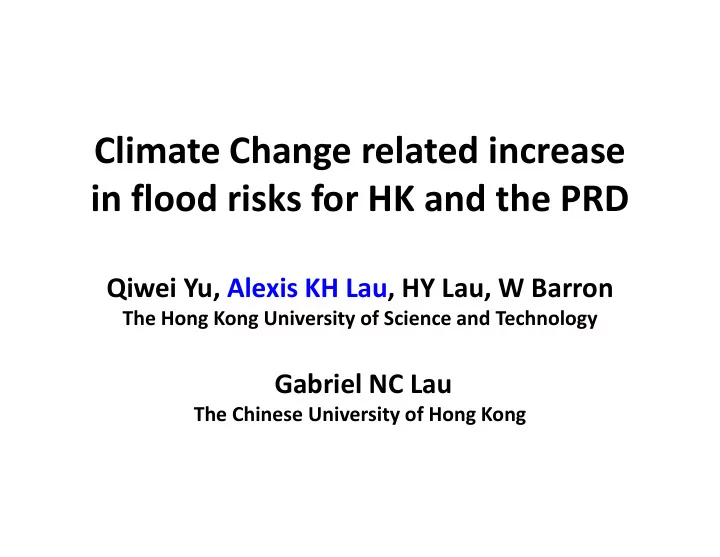

Climate Change related increase in flood risks for HK and the PRD Qiwei Yu, Alexis KH Lau, HY Lau, W Barron The Hong Kong University of Science and Technology Gabriel NC Lau The Chinese University of Hong Kong
HKO Sea Level Data Daily maxima sea level at NPQB (1954-2012) Threshold Number of Approximate case return period >340 cm 1 60 >330 cm 3 20 >320 cm 7 8 >310 cm 10 6 >300 cm 20 3 >290 cm 56 1 Return period is a critical Engineering design parameter 2
Approximate Threshold – 290 cm Threshold Number of case return period (current annual event) >340 cm 1 60 50 cm >330 cm 3 20 40 cm >320 cm 7 8 30 cm >310 cm 10 6 20 cm >300 cm 20 3 10 cm >290 cm 56 1 0 Projected Sea level rise Future annual Return period from 2000 maximum sea level by 2100 2030 +10 cm 300 cm ~3 2050 +20-25cm 310-315 cm ~6-7 2100 +40-80cm 330-370 cm 20-100+
Rising Sea Level in Hong Kong
1957-1984 1957-2012 1985-2012 data Shortening of Return Period
Source: IPCCAR5 WG1 2030 2050 2100 Sea level projections 10cm 20-25cm 40cm-75 cm
What does it mean to have a 100 year flood event ???
Global Active Archive of Large Flood Events ---Dartmouth Flood Observatory Duration - Derived from start and end dates. Known Dead - News reports are usually specific about this, but occasionally there is only mention of 'hundreds' or 'scores' killed Number Displaced - This number is sometimes the total number of people left homeless after the incident, and sometimes it is the number evacuated during the flood. News reports will often mention a number of people that are 'affected', but we do not use this. Damage (US $) - This number is never more than an estimate and we use no independent criteria for determining such. Instead we accept the latest and apparently most accurate number available in all the relevant sources. Main Cause - One of eleven main causes is selected: Heavy rain, Tropical cyclone, Extra-tropical cyclone…… Severity Class - 1, 1.5, 2.Class 1: large flood events: significant damage to structures or agriculture; fatalities; and/or 1-2 decades-long reported interval since the last similar event. Class 1.5: very large events: with a greater than 2 decades but less than 100 year estimated recurrence interval, and/or a local recurrence interval of at 1-2 decades and affecting a large geographic region (> 5000 sq. km). Class 2: Extreme events: with an estimated recurrence interval greater than 100 years. Geographic Flood Extents (sq km) - This is derived from our global map of news detected floods. Polygons representing the areas affected by flooding are drawn in a GIS program based upon information acquired from news sources Flood magnitude=log(severity *duration*area) 9
Flood events 1985/1-2013/7, Totally 4068 cases 10
Deaths Flood Impact Economic Displaced Damage
1. Data ellipse outlier detection -A clear increase trend and the data is concentrate in the ellipse ( 0.9 ) 2. From the origin -If flood magnitude is 0, there has no damage due to flood 3. Log-linear regression estimation
Vulnerability Difference 13
World Development Indicators ( Word Bank, Average of 1985-2012) 1 ……………. Country damage_rate GDP per capita Urban population (%) Employment ratio Telephone lines . China 3.0 1518.0 35.6 73.3 11.4 . United States 3.2 33184.2 78.5 61.4 56.4 . Philippines 3.0 1167.4 47.8 59.8 2.8 . Vietnam 2.9 544.5 24.4 76.4 5.2 . . . . . . . . . . . . . . . . . . . . . . Canada 3.6 27455.5 78.6 60.5 58.0 . Korea, Rep. 3.7 11849.5 77.7 58.9 43.7 . Argentina 2.7 6307.0 89.4 52.2 17.8 . Fiji 3.7 2681.1 46.4 56.1 9.9 Japan 2.8 33061.6 81.6 59.5 46.6 . New Zealand 3.2 17967.4 85.4 61.5 43.9 1. WDI take into consideration only if it has more than 20 years record
Categorized countries by Population density & Urban population (%) -Deaths/Displaced -Factor analysis -Identify the indicators represent the characteristic of the country -Where is Hong Kong & PRD locate? 16
Correlated indicators Death: • Rural population (% of total) (0.58) • Population density (people per sq. km of land area) (0.48) Displaced: • Population density (people per sq. km of land area) (0.65) • Rural population (% of total) (0.52) Cor (Urban population, Population Density) � 0.28 Economic Damage: • GDP per capita (constant 2005 US$) (0.43) • Telephone lines (per 100 people) (0.52) Cor (GDP,per capita & Telephone lines)=0.95 17
Impact for Hong Kong 2000 2030 2050 2100 Projected Sea level rise 0 cm +10 cm +20-25 cm + 40-80 cm from 2000 Return Period (years) 1.5 1.5 1.5 1.5 in the future Equivalent Return 1.5 ~ 3 6 – 7 20 – 100+ Period (years) in 2000 Flood magnitude 3.5 3.5+ 4 6 - 7 Number of deaths < 5 ~ 5 ~ 20 20 – 60+ Number of people < 400 400+ 1,000+ 5K – 150K displaced Economic loss < 25 25+ 60 – 600 800 – 6000+ (Million HKD) Impact estimates ASSUMED no protective measure being done in HK
Projected annual flood damages for Hong Kong & PRD in 2030, 2050 and 2100 without adaptation (flood magnitude: 3.5, 4, [6-7]) Year 2030 2050 2100 Return period at present 3 6~7 20-100+ Deaths Hong Kong ~ 10 ~ 20 20 – 60+ PRD ~ 30 ~ 40 100 – 700+ Displaced Hong Kong Up to 400 Up to 1,000 5000 – 150,000 PRD Up to 4,000 Up to 15,000 0.2 – 2+ million Economic Damage (HK Dollars) Hong Kong < 25 million 60-600 million 800–6000+ million PRD < 10 million 30–150 million 200–3000+ million Recovery duration Hong Kong & PRD Several days <1 month Several months 19 (>4 months)
Summary • Order of magnitude estimates • Significant impact without adaptation – need to work hard on that Guangdong 2013 Thailand 2011
Recommend
More recommend